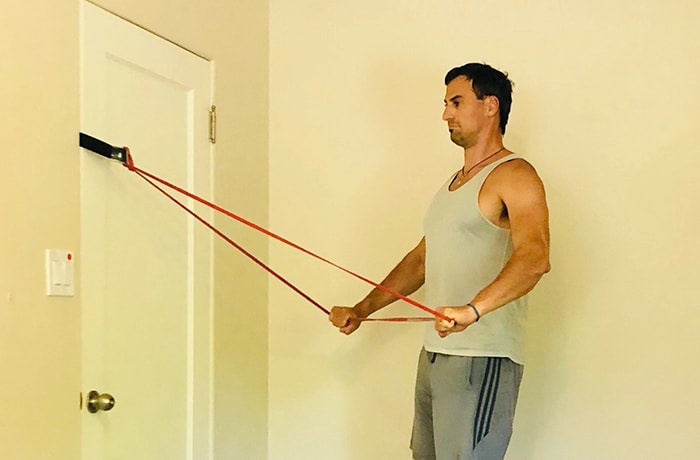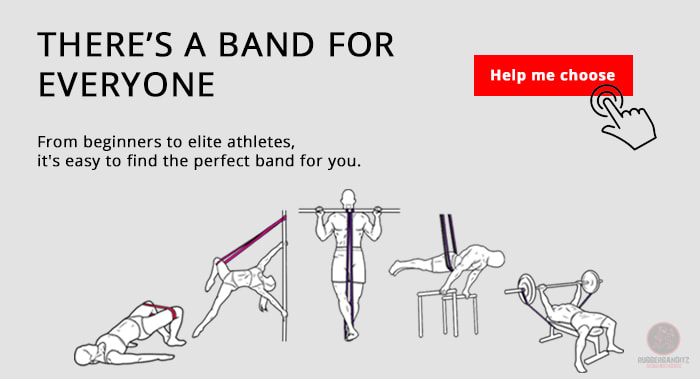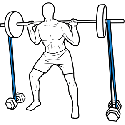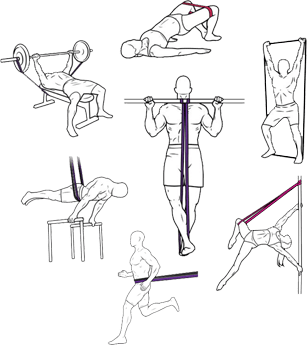How to and why to do a resistance band pull apart (use as warmup, supplement bench press, mobility, shoulder, etc). What muscles it works and other benefits. Variations of pull aparts
Hey all,
Today I’m going to teach you to eat your movement vegetables and I’ll even make them sound tasty.
The movement vegetable of today is the band pull apart. It’s kind of like the potato of back exercises. Looks boring to begin with, but if you peel back the layers, chop it up finely and deep fry it, it ends up thickening up those back muscles in a way few can truly appreciate. It can also be used in as many ways and for as many purposes as the potato can, a truly amazing feat for such a simple movement.
Before we jump into purposes and specifics though, let’s get a look in at what the workout band pull apart does and how it does it. Know this and the reasons you’d use it become all the more clearer to you anyway.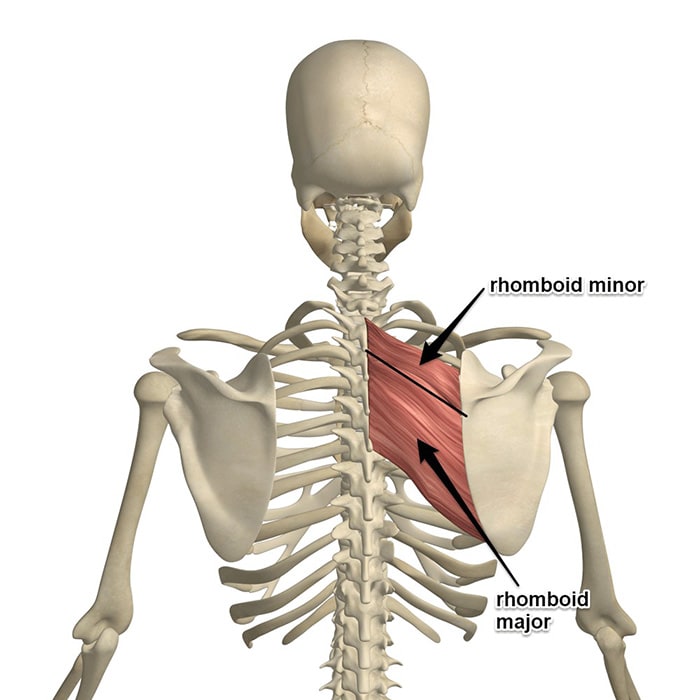
Here we have the rhomboid. Along with the serratus anterior, the rhomboids stabilize the scapula. Doesn’t sound like a hard job, right? That said, the scapula is a floating bone, meaning it can move a hell of a lot more than most. This means that the rhomboids and serratus need to be strong and mobile for any scapula to move properly.
I know what you’re thinking – I’m just here for that tasty band pull apart – I don’t care about a rhomboid. Let me stop you there.
Band pull aparts and their variations are the key to getting yourself a pair of juicy rhomboids (and also half of the formula to a stable, strong and pain-free set of shoulders). The rhomboids insert at the spine and underneath the scapula, so for them to do work your shoulder blades need to pinch together. This brings the scapulae towards the spine, thereby shortening the rhomboid muscle. On the other side of life, we need to spread our scapulae apart from one another to maximize the stretch on the muscle and the range of motion we can move the muscle in.
Luckily for us, the resistance band pull apart is a thing that exists and does a fantastic job of exactly this movement.
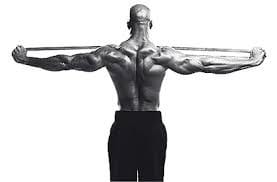
Look closely at the image. Firstly, we see some sort of back muscle development there! This guy clearly does his band pull aparts!
Secondly, all jokes aside, we see scapulae pinched together. If the trap muscles weren’t in the way, we would see the rhomboids doing the good work they do. This is at peak contraction, and as the workout band relaxes and we reach forward, we get exactly the stretch we need on the muscle.
Look closely at the image above. Firstly, we see some sort of back muscle development there! This guy clearly does his band pull aparts!
Secondly, all jokes aside, we see scapulae pinched together. If the trap muscles weren’t in the way, we would see the rhomboids doing the good work they do. This is at peak contraction, and as the workout band relaxes and we reach forward, we get exactly the stretch we need on the muscle.
So now that you know and we’ve cracked the pull apart code, we get a little insight into the ways and reasons for doing band pull aparts. We do them to strengthen the rhomboids, and as one part of a scapular stabilizing protocol to ensure our shoulders are stable and feel safe producing the force we’d so dearly like them to.
This is the reason for doing band pull aparts, now let’s look at the applications of this:
- Injury Prevention
- Warm Up
- Mobility
- Strength Training Supplement/Accessory
So the first on the list is injury prevention. As I said earlier, the rhomboid and the serratus are the central players in ensuring a stable scapular, and by extension a stable shoulder. That SLAP/rotator cuff tear you had was probably linked to this. Same with that nagging pain in your shoulder you’ve maybe been nursing the last couple months.
Rotator cuff tears (at least in the training sense), often come about because the tiny little fellas are left doing the work of the rhomboids and serratus, two muscles much bigger and stronger than them. Left with too much work to do, they give up and do themselves in, tearing in the process. (Ok, so muscles don’t make decisions that way, physics does, but so what?) Either way, you can see that strengthening the rhomboids will make a massive difference in reducing the risk of tearing the rotator cuff and keeping a healthy shoulder joint.
The same can also be said for neck, shoulder, elbow and wrist pain. If the shoulder sits correctly in the joint and the upper traps don’t create issues for the brachial plexus (sorry, I know you might need Google for this one, it’s a doozy), quite often the common neck, elbow and shoulder pains relieve themselves because these muscles are being overused in place of a weak and incapable rhomboid.
Now that we’ve seen how fitness band pull aparts can do their part to help lower the risk of overuse injuries in the shoulder complex and down the arm, let’s move on to their uses in mobility and warming up.
As we’ve already discussed, the rhomboids and serratus stabilize the shoulder. To ensure our shoulders are stable, strong and ready for action, we should probably activate these muscles prior to training right? I mean- it’s great to have a strong rhomboid, but even the best of us might struggle to use it after a long day with our shoulders hunched at work or day tripping in a car. For this reason, we should consider adding the band pull apart into our warm up. All of us are human and will have days where certain muscles are easier and harder to connect to and this is an easy way to ensure we are connecting to and stimulating them regularly.
The same can be said, but slightly differently for mobility. For those of you with tight shoulders and chest muscles, a main consideration for you in loosening them up should be strengthening opposing muscle groups (like, surprise surprise, the rhomboids!). A lot of people stretch their pecs and shoulders for weeks at a time with no success, but this is because they have no active ability (read: strength) in opening their chest or shoulder blades, which is effectively enough done by (yep, you’ve guessed it) the resistance band pull apart.
At this point, I just want to take a moment to fully stop and think about it. Injury prevention, mobility, and warm up exercise already. All in such a simple movement. Amazing right?
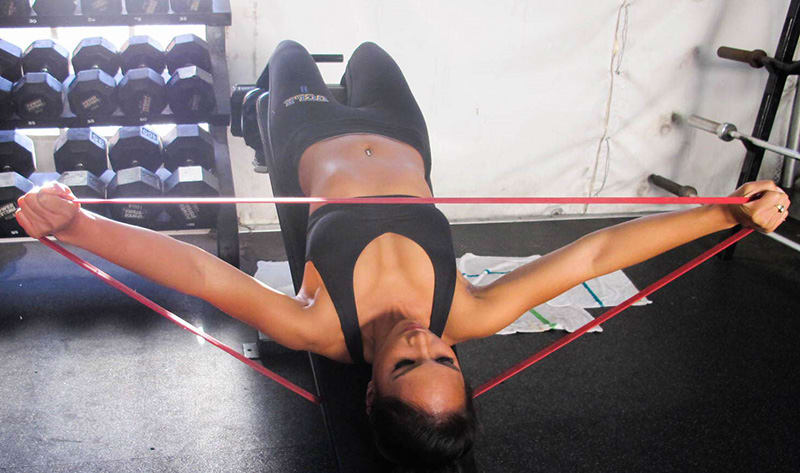
Alright, now that we’ve soaked all that in, let’s look at how it can supplement strength training. I think, in an attempt to not be too vague, I’ll specify that it is particularly useful for bench pressing, for a couple reasons. The first is one I don’t have to repeat again… scapular stability. The second is a little more nuanced, and comes back to active range and strength opening up the chest muscles.
Quite often, the best benchers of the world and all time have a lot to say about the back muscles and the need for them in a bench press. As the bench press gets heavier, the arch in a powerlifting style bench press gets harder to maintain because there is more weight and gravity bearing down on that arch while you bench.
To sustain both that arch and a stable set of shoulders, we need to ensure our back muscles are strong enough to maintain the arch and extension while we bench. If we can’t actively pinch and depress the scapula we lose the arch, and by extension, the ability to bench press the most possible weight and the safety in doing so too.
So now that we know why to do exercise band pull-aparts and their variants, how are they done and what variations are there to do? And how should I, the reader, be doing them?
As I stated earlier, pinching the scapula is central to using the rhomboids. To ensure a decent form, we should aim to keep shoulders, elbows and hands at similar heights. This ensures the lats aren’t particularly involved in the movement. The only other central considerations to doing this correctly is ensuring the rotation at the shoulder joint and the elevation at the scapula don’t get in the way of proper rhomboid work. THIS MEANS YOU DESK WORKERS! DRIVERS!
A lot of people bring their shoulders towards their ears when doing banded pull aparts and this should be avoided if proper rhomboid development is wanted.
Outside of this banded version, I also really enjoy doing the same motion with light dumbbells (and I mean very light) dumbbells in the hands. Another exercise that comes into similar discussions to the resistance banded pull apart is the ITYW. Think of the variation I’m discussing here as the T element, but with weights in your hands.
I really like this variation because the face lying position means that you are directly resisting gravity when you pull, rather than working across it as you would with a standing face pull apart. It is also a more consistently measurable way to progress.
If you need and insist on variations galore, I also see doing this same exercises with cables as possible, but not necessarily offering any distinct benefit except another option that might better satisfy your preference.
The final question, “how should you be doing these exercises?” depends on the way you are using them. For shoulder health, I personally do these with a light to medium weight resistance band (one of the two lightest bands in the link), high repetitions (15-30) to warm up whenever I train my upper body. Done this way, you could do them, hypothetically speaking, pretty much as much as you could want.
If you don’t want to spend warm up time on these every day, I would recommend at least twice a week before upper body pulling and pushing sessions (or in between working sets) for 3 to 4 sets.
My 3 favorite variations of these are performed as follows:
- The traditional pull apart. The classics are classics for a reason and this is no exception.
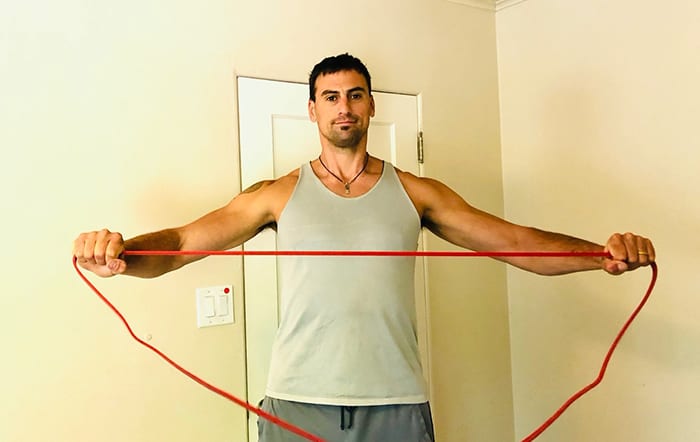
To do a traditional pull apart grab a light band with your hands about shoulder width apart (make them narrower if this is too easy). Bring your shoulders as close to your ears as possible, then take them as far away from your ears as possible and keep them there throughout the set. From here, try to pull the band apart, ensuring your shoulders don’t shrug up towards the ears and you keep your hands at roughly the same height as the shoulders. Pause when the workout band touches your chest and return to the starting position. - The Face-Pull Apart. External rotation makes most shoulders happier.
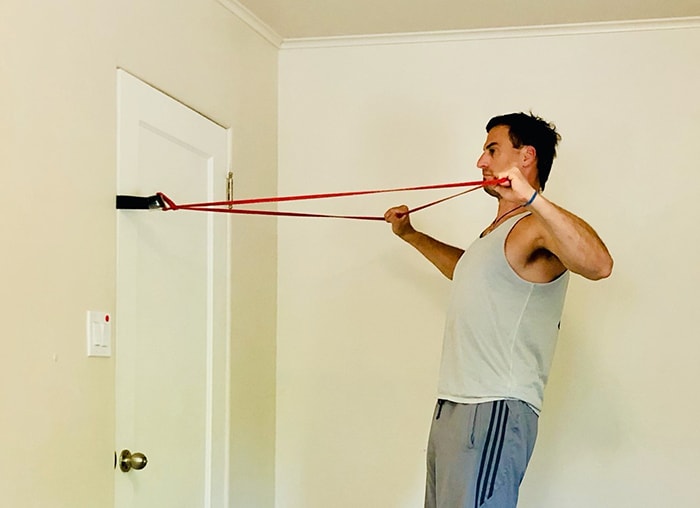
The face-pull apart still needs a light band. With this one, we tie it around a post at just above shoulder height, grab onto the fitness band with hands shoulder width apart. From here we pull our elbows back until they are in line with our shoulders and pinch our shoulder blades together. We keep our shoulders down, and our elbows stay in line with our shoulders, but our shoulder rotates and our hands end up above our elbows as our shoulders rotate. After we have ended up in this position, we return to the starting position and go again. - The Chest Pull Apart.
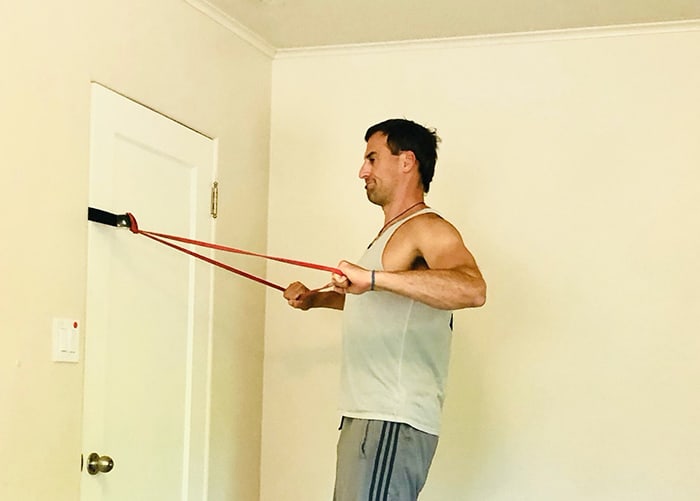
This one here is the exact same as the face pull apart EXCEPT, we do not rotate our elbows once we have pinched our shoulder blades together. Because we aren’t rotating, we can use a heavier band and really challenge our rhomboids with this movement. -
The Waist Pull Apart.
One other variation is to engage the upper lats and traps as you pull the resistance band down [and out] towards the waist. Make sure to hold the rep briefly before releasing.
